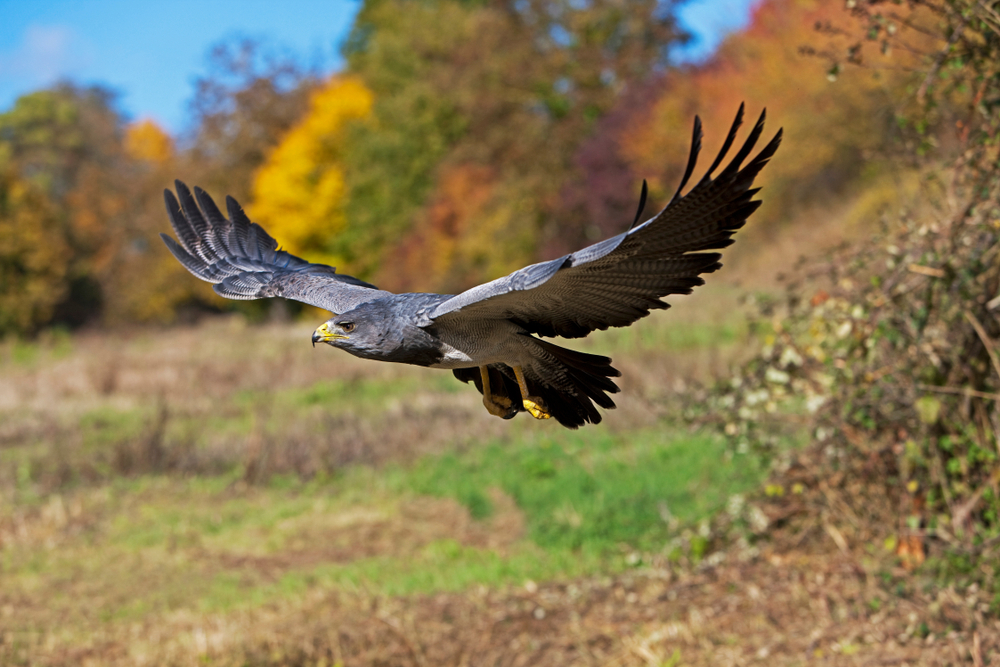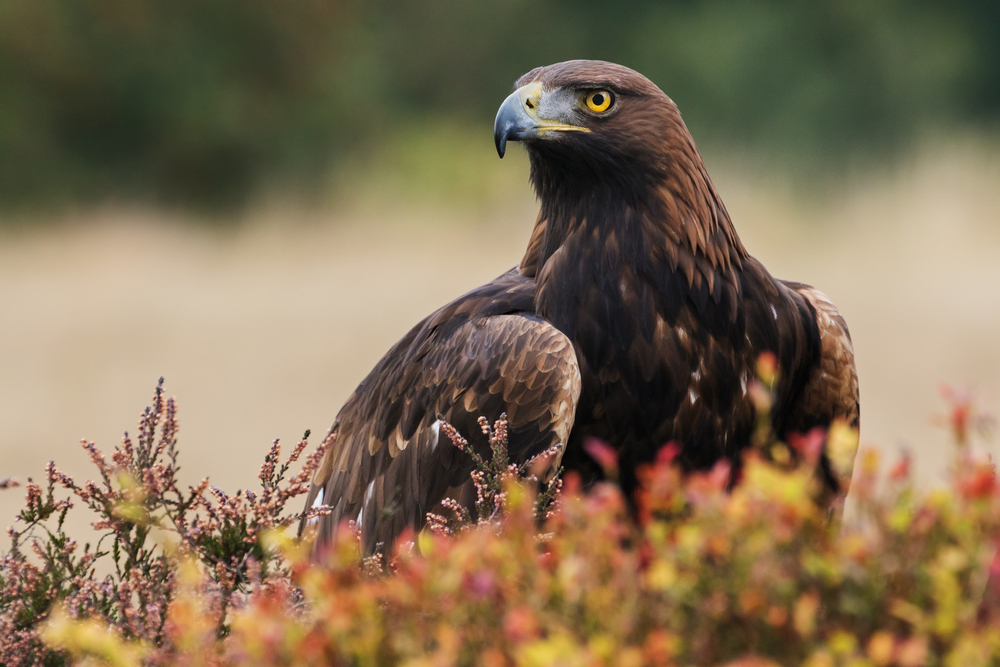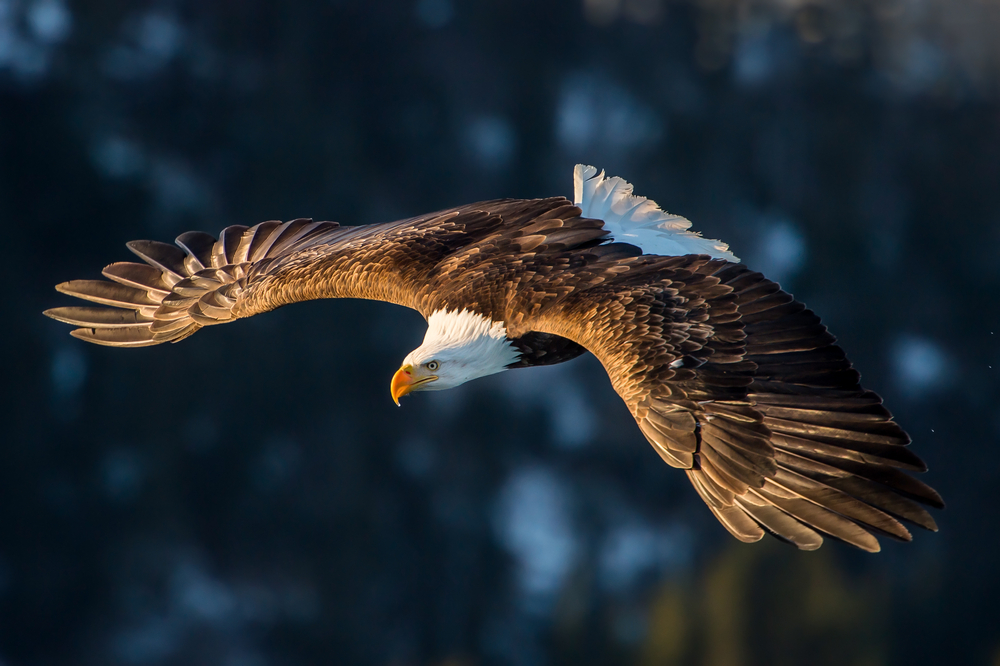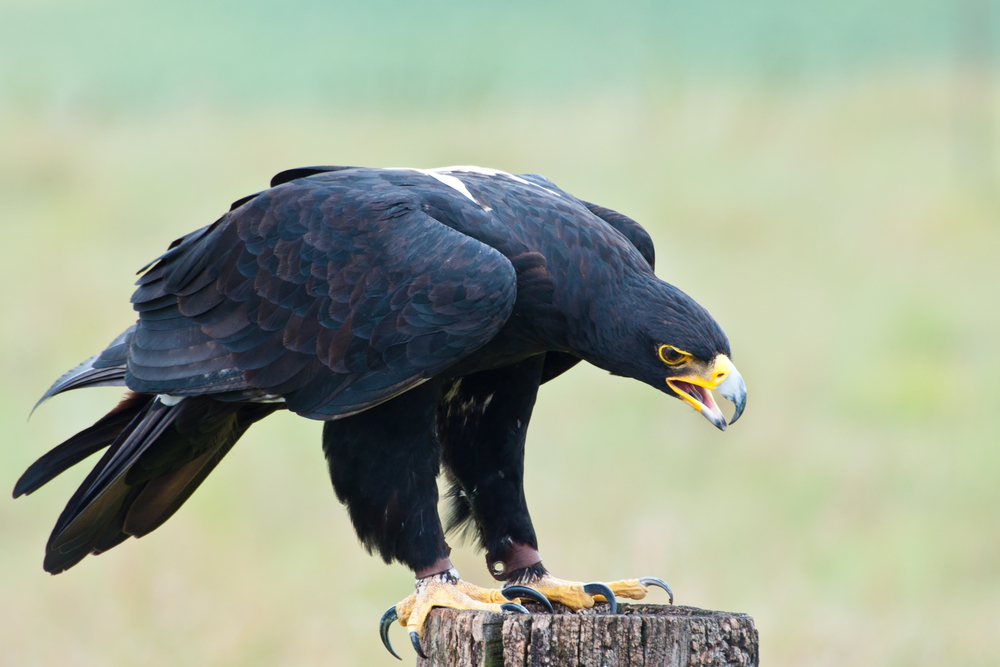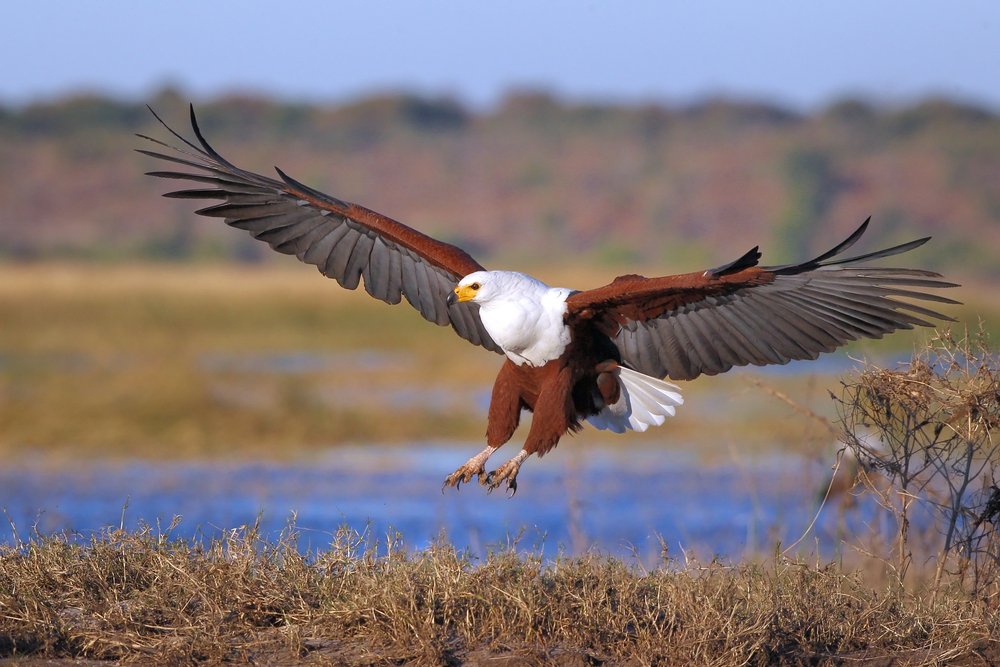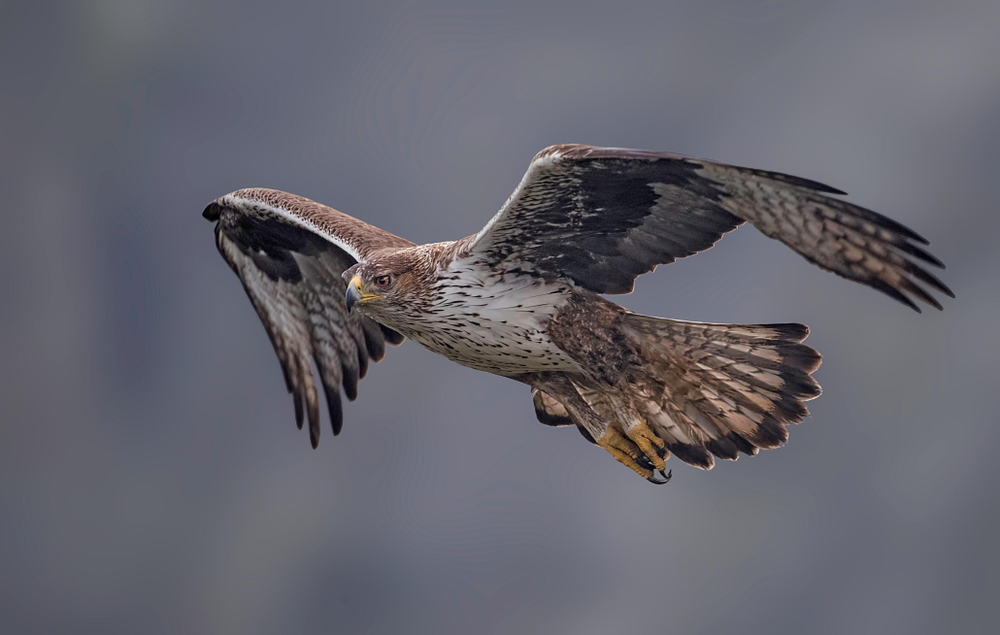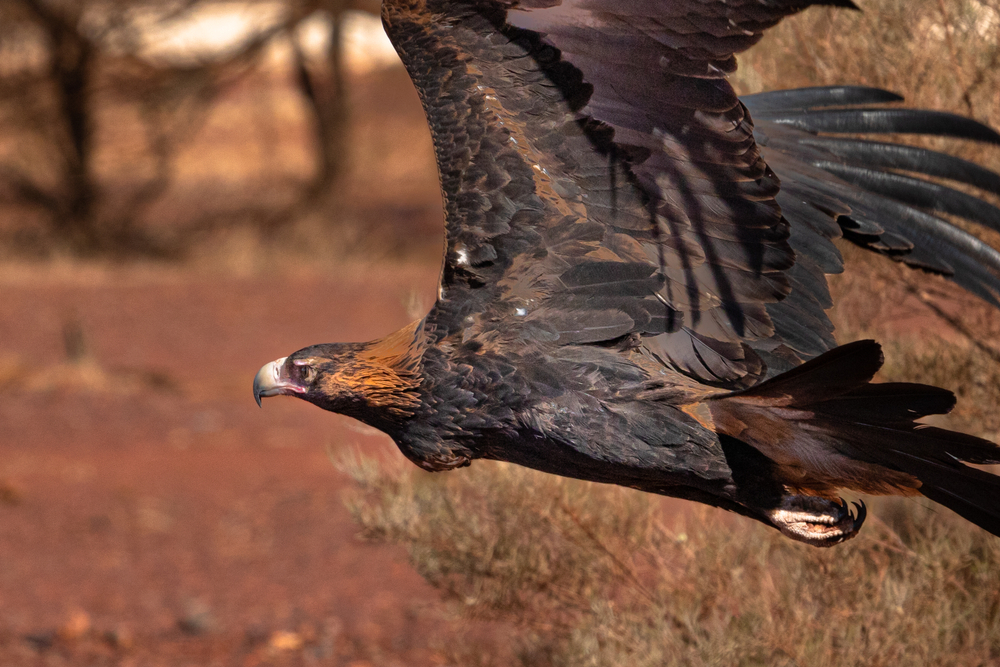Despite its name, it is an eagle. The term “buzzard” reflects its resemblance to large buteo hawks (commonly called buzzards in Europe), but taxonomically it is classified as a true eagle in the family Accipitridae. Its size, power, and hunting ability place it firmly among eagles, though its soaring style is buzzard-like.
About
The Black-chested Buzzard-Eagle is a large and powerful raptor native to South America, where it soars over mountains, open plains, and rugged landscapes. Known for its commanding presence and striking coloration, it has a dark gray to black back, wings, and chest, contrasted with lighter gray underparts and a white belly. Its broad wings and long tail make it a strong and skillful flyer, capable of soaring for long periods while scanning for prey.
This eagle-like buzzard typically measures 70–80 cm (28–31 in) in length, with an impressive wingspan of 180–200 cm (6–6.5 ft). Despite its size, it is remarkably agile, diving swiftly to catch prey such as rabbits, hares, rodents, and birds. It also scavenges carrion when the opportunity arises. The bird’s hunting technique usually involves soaring at high altitudes before plunging into a rapid stoop, using its strength and sharp talons to secure prey.
Breeding occurs in cliffs and high rocky outcrops, where pairs construct large nests of sticks. The female typically lays one or two eggs, with both parents contributing to incubation and care of the chicks. Young birds fledge after about 70 days but may remain dependent on their parents for some time. In the wild, these raptors can live up to 20 years.
The scientific name of the Black-chested Buzzard-Eagle is Geranoaetus melanoleucus, and it belongs to the family Accipitridae, which includes eagles, hawks, kites, and harriers. Although it is widely distributed from Colombia and Venezuela southward to Argentina and Chile, local populations are sometimes affected by habitat changes and hunting pressure. Nevertheless, it is currently classified as a species of Least Concern due to its large range and adaptability. As one of South America’s most iconic raptors, the Black-chested Buzzard-Eagle symbolizes the strength and grandeur of the continent’s open skies.
Physical Characteristics
The Black-chested Buzzard-Eagle (Geranoaetus melanoleucus) is a large, powerful raptor native to South America, known for its striking coloration and commanding presence.
Plumage:
Adults display a dark gray to black back and upper wings, contrasting sharply with their white underparts. Their name comes from the bold black chest band that stands out against the pale body. The tail is broad and white with a dark terminal band, highly visible in flight. Juveniles are mostly brown with mottled markings, gradually developing the adult plumage over several years.
Head and Face:
They have a robust head with a dark gray crown, a powerful hooked beak, and piercing yellow eyes. The cere and legs are yellow, adding contrast to their otherwise gray-black coloring.
Body and Wings:
This eagle has a massive, stocky body with broad wings adapted for soaring over open landscapes. The wings are long and rectangular, with a slightly rounded tip, built for strength and endurance rather than speed.
Size:
-
Length (Body): 27 to 32 in (70 to 80 cm)
-
Wingspan: 72 to 86 in (180 to 220 cm)
-
Tail Length: 10 to 12 in (25 to 30 cm)
Weight:
-
Males: 4.4 to 6.6 lbs (2 to 3 kg)
-
Females: 6.6 to 9.9 lbs (3 to 4.5 kg), making them significantly larger than males.
The Black-chested Buzzard-Eagle’s contrasting black-and-white plumage, heavy build, and broad wings make it one of the most distinctive and imposing raptors of South America.
Reproduction
The reproductive cycle of the Black-chested Buzzard-Eagle reflects its life as a long-lived raptor, with large territories and high parental investment.
1. Mating and Courtship:
Black-chested Buzzard-Eagles form monogamous pairs, often remaining together for life. Courtship displays include soaring in wide circles, steep dives, and dramatic aerial calls. Pairs are highly territorial and defend nesting sites fiercely.
2. Nesting:
Nests are built on cliff ledges or tall trees, constructed from large sticks and lined with softer materials such as leaves, wool, or animal fur. Some nests are reused for many years, with new material added each season until they become massive structures.
3. Egg-Laying:
The female lays 1 to 3 eggs, most often 2, between late winter and early spring depending on region. Eggs are white with light brown markings.
4. Incubation:
Incubation lasts about 38 to 40 days, carried out mainly by the female while the male provides food.
5. Raising Chicks:
Chicks hatch covered in thick white down and are brooded constantly in their early days. Both parents provide food, though asynchronous hatching often leads to siblicide, with the stronger chick outcompeting the weaker for food.
6. Fledging and Independence:
Young fledge at around 70 to 80 days of age, but remain dependent on their parents for several more weeks as they learn to fly and hunt. Independence usually occurs in late summer.
The reproductive strategy of the Black-chested Buzzard-Eagle emphasizes low clutch size, prolonged parental care, and strong pair bonds, ensuring the survival of only the fittest chicks in their demanding South American habitats.
Lifespan
The Black-chested Buzzard-Eagle is a long-lived raptor, with survival shaped by territory stability, prey abundance, and human impact.
Lifespan in the Wild:
In natural conditions, they typically live 15 to 20 years. Mortality is highest among juveniles during their first year, when learning to hunt and defend themselves. Adults that secure strong territories often enjoy much longer lives.
Lifespan in Captivity:
In protected environments such as zoos or conservation facilities, Black-chested Buzzard-Eagles can live 25 to 30 years, benefitting from consistent food supplies, veterinary care, and protection from predators and human threats.
Threats to the Black-chested Buzzard-Eagle:
-
Persecution: In rural areas, they are sometimes shot or poisoned due to mistaken belief they prey on livestock.
-
Habitat Loss: Conversion of natural grasslands and shrublands to agriculture reduces prey and nesting sites.
-
Electrocution: Power lines pose a risk, particularly to young and inexperienced birds.
-
Food Scarcity: Declines in prey species such as rodents and hares can affect breeding success.
-
Juvenile Mortality: Sibling rivalry and inexperience in hunting contribute to high losses in early life.
Care and Protection:
Conservation actions, including education programs, habitat protection, and reducing persecution, are vital for sustaining populations. Long-term survival depends on maintaining healthy ecosystems where prey is abundant.
The Black-chested Buzzard-Eagle’s long lifespan and low reproductive rate make it vulnerable to human pressures, but also a symbol of strength and endurance in South American skies.
Eating Habits
The Black-chested Buzzard-Eagle is a carnivorous predator with a diet centered on medium-sized mammals, birds, and reptiles, reflecting its adaptability across South American habitats.
Diet:
Their primary prey includes rodents, rabbits, hares, armadillos, and small foxes. They also hunt medium-sized birdssuch as pigeons, partridges, and ground-dwelling species, as well as reptiles like lizards and snakes. On occasion, they scavenge carrion.
Hunting Strategy:
These eagles are soaring hunters, often seen gliding high above open terrain, scanning for prey. Once spotted, they dive in powerful stoops, striking with strong talons. They may also hunt from perches, launching sudden attacks.
Killing Technique:
Prey is seized and subdued with powerful talons. Small animals are killed on impact, while larger prey is dispatched with crushing grips and tearing from the hooked beak.
Feeding Behavior:
They typically hunt alone but may be seen in pairs during breeding season. Prey is carried to a perch or nest, plucked or skinned, and then fed to chicks in torn pieces.
Special Considerations:
-
Dietary Flexibility: Capable of shifting diets based on local prey abundance.
-
Ecosystem Role: As apex predators, they help regulate populations of small mammals and birds.
-
Juvenile Training: Parents bring live or freshly killed prey to nests, enabling chicks to practice tearing and handling food before independence.
The Black-chested Buzzard-Eagle’s powerful build, soaring flight, and adaptable diet make it one of South America’s top avian predators.
Uniqueness
The Black-chested Buzzard-Eagle is one of the most imposing raptors of South America, celebrated for its striking plumage, commanding flight, and ecological importance.
Distinctive Plumage:
Its white underparts with a bold black chest band, paired with dark gray upperparts and a broad white tail with a black tip, make it one of the most easily recognized eagles in the region.
Massive Build:
With a wingspan reaching up to 7 feet (220 cm), it is among the largest South American raptors. Its broad wings and heavy body allow it to soar effortlessly for long periods over mountains and open plains.
Powerful Predator:
This eagle is a formidable hunter, capable of taking down mammals as large as hares and young foxes. Its strength and adaptability give it a dominant role in the ecosystems it inhabits.
Cultural Significance:
In several Andean regions, the Black-chested Buzzard-Eagle is seen as a symbol of power and freedom, often appearing in folklore and traditional stories.
Ecological Role:
As an apex predator, it regulates populations of rodents, rabbits, and medium-sized birds, maintaining balance in grassland and shrubland ecosystems.
The Black-chested Buzzard-Eagle’s combination of massive size, striking appearance, and top-predator status makes it one of the most unique and admired raptors of the South American skies.
Be the First to Share Photos of This Species.
FAQ’s
1. Is the Black-chested Buzzard-Eagle an Eagle or a Buzzard?
2. What is the closest species to the Black-chested Buzzard-Eagle?
The closest relatives of the Black-chested Buzzard-Eagle are other large buteo-like eagles, particularly the White-tailed Hawk (Geranoaetus albicaudatus) and the Chilean Hawk (Accipiter chilensis). Taxonomically, it belongs to the genus Geranoaetus, which groups it with South American raptors that resemble both eagles and buzzards.
3. How does the Black-chested Buzzard-Eagle compare to other eagles?
It is smaller than giant eagles like the Harpy or Golden Eagle but is still among South America’s largest raptors, with a wingspan up to 7 feet (220 cm). Compared to true eagles (Aquila), it has broader wings and a heavier build, more similar to buzzards (buteos). Its bold black chest band and white tail make it highly distinctive in flight.



































































